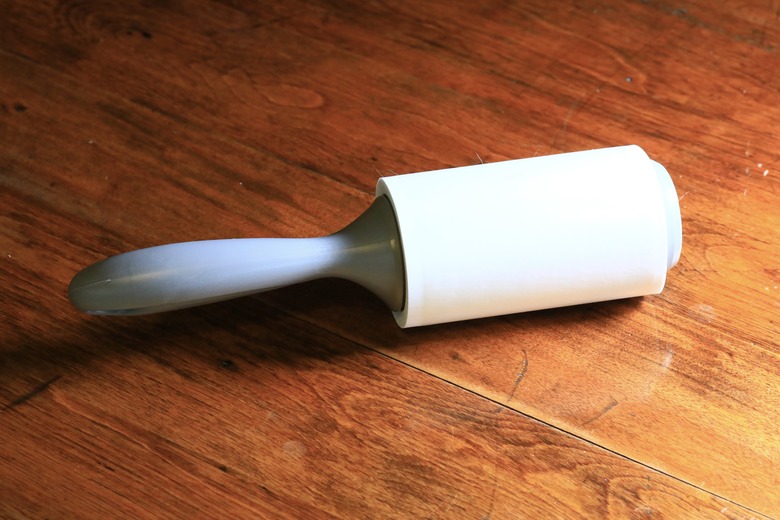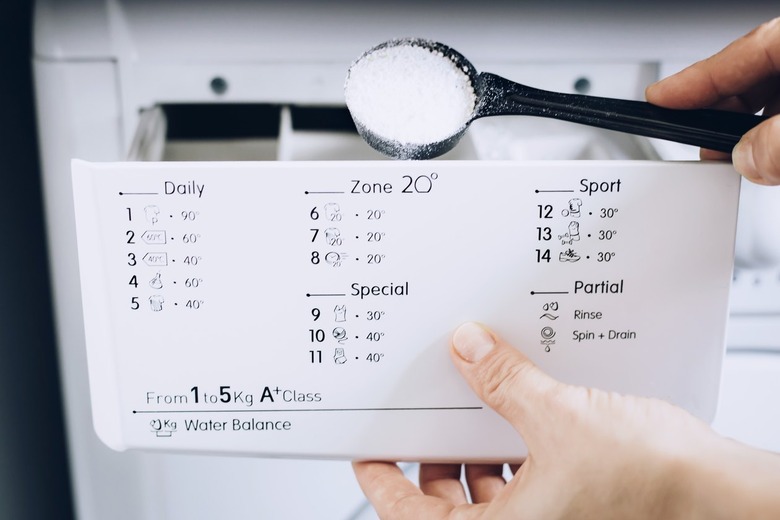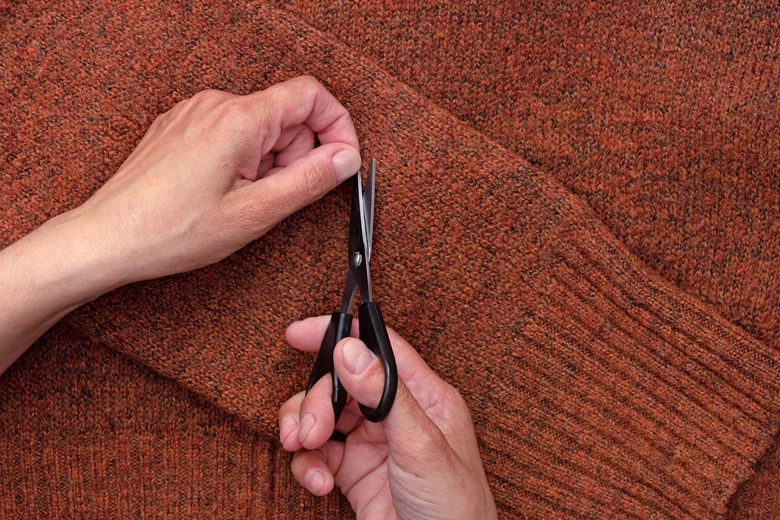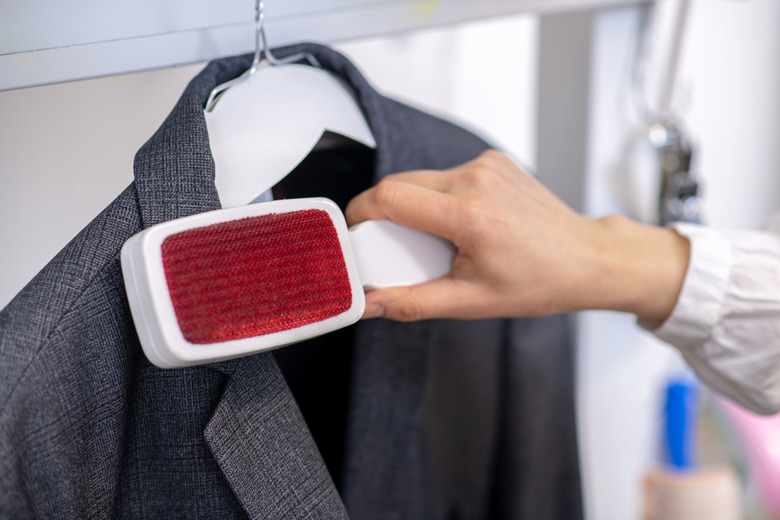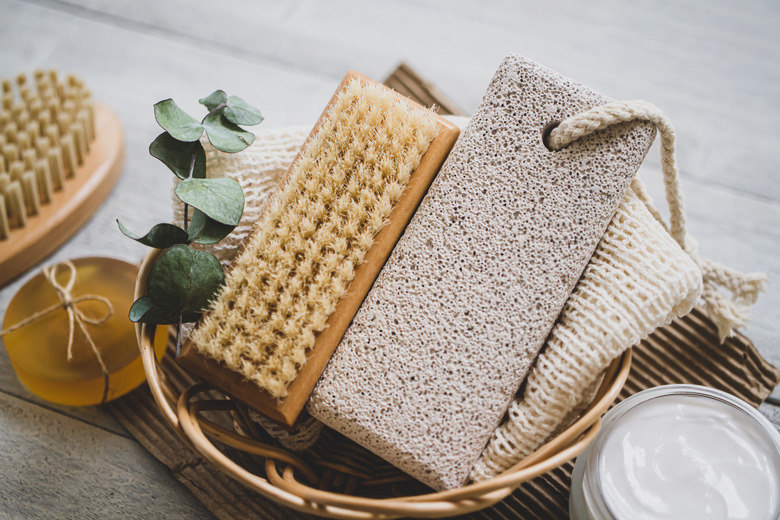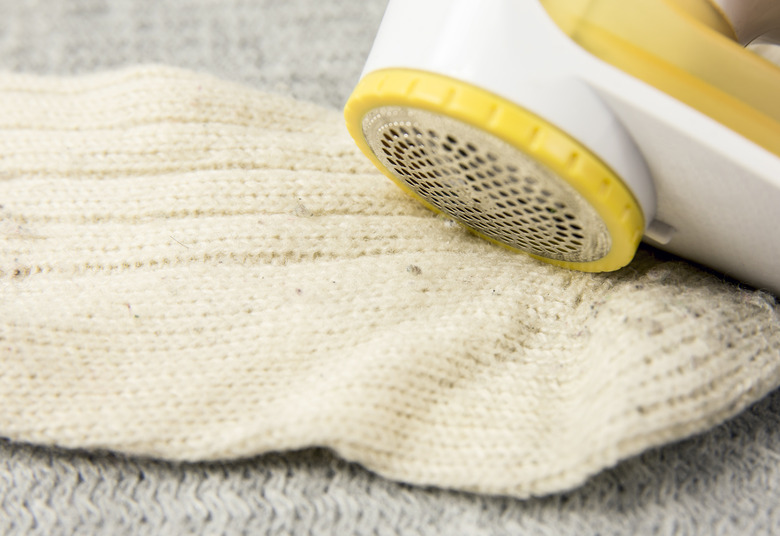How To Remove Lint From Clothes: 6 Genius Methods
We may receive a commission on purchases made from links.
Knowing how to remove lint from clothes is one of those basic adult skills that everyone needs to have, but most of us don't actually feel that confident about it. When you notice white lint on your dark clothes, are you supposed to run them through the dryer again? Use a lint roller? Or is a lint brush better? What if you don't have a lint roller or a lint brush?
Maybe there are other lint removal questions plaguing you too. Why does your nice wool coat always seem to be covered in fuzz no matter what you do? Is there some secret for getting stubborn pet hair out of your clothing? And how do you wash clothes to keep lint and fabric pilling from happening in the first place?
Wonder no more. Here are six genius methods to remove lint from clothing — and whatever else in your household that is a bit extra fuzzy.
1. Wash Your Clothes the Right Way
1. Wash Your Clothes the Right Way
There's no way to totally stop your clothing from creating lint, but washing clothes correctly minimizes how much friction and heat the fabrics are exposed to each time they're cleaned. Here are some quick tips to ensure your laundry comes out lint-free:
- Turn clothes inside out and make sure closures like zippers and buttons are fastened to keep them from snagging on other things in the washer.
- Use cold water in the wash cycle (unless you're washing something that needs to be sanitized) and whatever kind of gentle laundry detergent you normally use.
- Don't overfill the washer beyond what the manufacturer suggests in terms of load size. The more fabric in the machine, the more everything's going to rub together.
- Allow clothes to air dry whenever you can, especially any items that have started to pill.
- When you have to use the dryer, always check the lint trap first to make sure it's empty.
- Dry clothes on the lowest heat setting and don't let the dryer run for any longer than necessary.
- Empty the lint trap after every use to keep the dryer working at peak efficiency and to prevent lint buildup.
Warning
Lint on your clothes is annoying, but lint in your dryer can be dangerous. It's flammable, and lint buildup inside the dryer can reduce airflow and contribute to a fire that starts inside the dryer and spreads. Failure to clean a dryer is the leading cause of dryer fires, according to the National Fire Prevention Association (NFPA). The NFPA's most recent data from 2018 showed an average of 13,820 house fires caused by dryers every year, with 27 percent of those fires caused by lint buildup.
In addition to clearing the lint trap after every use, it's essential to clean lint buildup from the dryer vent pipe regularly. The NFPA recommends cleaning out the vent pipe at least once a year or more often if the dryer isn't working efficiently. A dryer maintenance service can do this, or you can use a dryer vent cleaning kit with a hose that attaches to your vacuum. (Double-check that the dryer is disconnected from power before starting.)
2. Experiment With Laundry Add-Ins
2. Experiment With Laundry Add-Ins
A lot of popular lint hacks involve adding something to the washing machine and/or dryer to prevent clothes from creating and attracting lint. All of these methods have varying degrees of effectiveness, and they all have some potential downsides too. In other words, there's no one magic ingredient you can add to your washer that will solve your lint problems, but there are some strategies you may or may not want to try.
- Fabric softener: Adding fabric softener when you're washing clothes coats them with a thin layer of chemical compounds that reduces static and makes fabrics feel smooth and soft. That coating may help minimize the fiber breakage that causes lint. But using fabric softener has several potential drawbacks, including the possibility that the chemicals will cause skin irritation for someone in your household. Other drawbacks include the fact that the residue can also damage your dryer over time and make towels less absorbent. Plus, fabric softener is an extra expense.
- Dryer sheets: Like fabric softener, dryer sheets can reduce static electricity in the dryer. That means lint that's broken off your clothes during the drying process should be less prone to stick to other fabric. One downside is that single-use dryer sheets create waste. Also, like fabric softener, dryer sheets leave residue on your clothing and inside your dryer, and they use chemicals that some people are sensitive to.
- White vinegar: White vinegar has a reputation as an all-purpose solution for household problems, so it's not surprising that vinegar is often credited as a lint eliminator on TikTok, among other places. In our experiment, adding 1 cup of white vinegar to a load of towels didn't create any noticeable reduction in lint, and the clean towels smelled faintly of vinegar.
- Dryer balls: Adding several wool dryer balls to the dryer reduces static electricity, eliminating the need for dryer sheets and helping to ensure lint gets pulled into the lint trap instead of sticking to other clothes. (Despite being made of wool, dryer balls themselves shouldn't give off lint beyond their first few uses.) The biggest downside with using dryer balls is that they're noisy.
3. Snip the Lint Balls Off Items Like Socks
3. Snip the Lint Balls Off Items Like Socks
It makes sense that socks would develop a lint problem. Our socks are constantly exposed to heat and friction against our feet and shoes as we walk around throughout the day, so some of those fabric fibers will naturally start to break and pill. Walking around barefoot in socks will also collect random fluff and fibers from carpets and the floor. Eventually, your socks might start to pill so much that you can actually feel little bumps under your feet. And with black socks especially, you'll see all that lint and pilling every time you look down at your socked feet.
Use a pair of small, sharp scissors to cut off the pills that form on socks, gloves, scarves, and other smaller items of clothing. Hold the fabric between your knees and use one hand to pull it taut while you lift and snip off the little fuzz balls with the other. This strategy makes it easy to target each lint ball without making any nicks in the fabric. You could also snip off individual lint balls from a sweater or coat that's started pilling, but this would be a fiddly and time-consuming process. There are usually better ways to deal with lint on larger garments.
4. Try Conventional Lint Removers
4. Try Conventional Lint Removers
There's always some genius new gadget being invented, but sometimes, the tools that worked for our great-grandparents still work perfectly well to solve today's problems. There are three common lint removal tools that people have been using to keep clothing lint-free for the last 50-plus years.
- Masking tape: Wrapping a loop of masking tape around your hand sticky side out is a quick and easy way to pull up lint and other visible debris without damaging fabric. (The inventor of the lint roller actually used masking tape wrapped around a toilet paper tube when he made his invention in 1956 after forgetting to take his suit to the dry cleaner.)
- Lint rollers: One type of lint roller is made from single-use adhesive sheets wrapped on a tube that fits onto a plastic spindle. Peeling away the top sheet reveals a fresh sheet that's sticky enough to pick up lint and pet hair as you roll it across the fabric. The alternative is a reusable lint roller, which has a tacky plastic surface that can be washed with soap and water without losing its slightly sticky quality.
- Lint brushes: A lint brush typically has a plastic handle and a fabric head. Rubbing the brush firmly over fabric, always moving in the same direction, should lift lint onto the brush. Wipe the brush onto a cloth or your hand to remove the lint. A lint brush tends to be slightly less effective than an adhesive lint roller for picking up stubborn debris, like pet hair, but it's generally pretty good at minor lint removal, and one lint brush can last for many years.
5. Use a Pumice Stone
5. Use a Pumice Stone
The slightly abrasive surface of a pumice stone can be very effective for de-pilling a sweater or other knit garment. You can always experiment with a clean pumice stone you have around the house or use a sweater stone that's made to be used on clothing. Pumice stone works better on some kinds of fabric than others. It tends to be better suited for removing pills from tight knits than from loose knits. If you want to try this method, start with a test patch in an inconspicuous area of the garment (like along a hem or under the armpit) to see how well the pumice stone works.
6. Shave and Scrape
6. Shave and Scrape
The problem with using a fabric shaver is that it's so much fun that you'll be bummed once your sweaters, coats, and couches are free of fuzz, and you have to turn it off. These gadgets have gone viral on social media because of how satisfying and effective they can be to use on a variety of fabrics. Shaving pilled fabrics with a disposable razor is much more time-consuming but might also work. Never shave clothing while you're wearing it; stretch it across a flat surface instead.
A pet hair scraper can also be a hugely useful tool if you share your space with a furry friend. Hair that won't budge for a lint roller should come out of your furniture and clothing when you scrape it up. You can also wear a clean rubber glove, get the fingertips damp, and drag your gloved hand across fabric to pull up pet hair.
What About Aspirin?
What About Aspirin?
There's another strategy for how to remove lint from clothes that's gained popularity on social media: soaking or washing clothes in water with aspirin dissolved in it. This tip is commonly suggested for dealing with clothes that have been accidentally washed with tissue and are covered with tons of little paper bits. We tested it by soaking jeans covered in tissue lint in a bath of water and two dissolved aspirin for two hours. Some of the tissue bits did fall away, but the jeans still needed to be lint rolled after drying, so the aspirin step didn't have much payoff.
What Fabrics Make the Most Lint?
What Fabrics Make the Most Lint?
How much lint a fabric will give off depends on how the fabric is constructed. Fabrics made with shorter fibers (including cotton, wool, and synthetics) will generally be more prone to pilling than fabrics made from longer fibers (silk and linen). How tightly a fabric is knit or woven also affects pilling. The more tightly packed the fibers, the more friction and breakage will occur.
